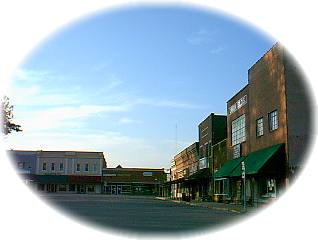
Dedicated in 1915 by Vice President Thomas Marshall and rededicated after restoration in 1987 by George Bush, the square and bandstand, listed on the National Register of Historic Places, remain the hub of the downtown business district and host to concerts, festivals, and other activities.
When the railroad came to Mountain Grove in 1882, Joseph Fisher bought land for a depot and platted a town. Also in 1882 Dr. Isaac Lane bought the land north of Fisher's and laid out streets and a square. He also gave plots of land to some businesses willing to locate around the new square. It was Lane who understood that a space must be provided for the rural people who came to town to trade. At first, an area of brush and trees on the north part of Fisher's land blocked the square from the depot. One night a "nipping frost" cleared all this growth and formed a visual link between depot and square which was maintained for many years.
In 1885 Professor Baker, a local teacher, started a brass band, the first in town. The paper reported Baker's band was "able to discourse excellent music greatly to the credit of all concerned."
The current bungalow-style bandstand is the second in the Mountain Grove square. The earlier bandstand was a Victorian stick-style affair of two stories. It was built during the 1880s, possibly in time for Baker's brass band to perform there.
On Aug. 3, 1915, Thomas R. Marshall, then vice president of the United States, dedicated the new bandstand to "the average man." That evening Marshall urged his hearers "to maintain neutrality," but before long the town, and the rest of the country, would be involved in World War I.
During both world wars the square was used for bond rallies and Red Cross auctions. Stella Brooks remembered that during the first world war, "They used to let all the girls out of school so we could go get apples from the fruit station to give the soldiers when they came through on the troop trains." In 1917 the local paper reported that 13 Pullman cars of soldiers stopped en route from Iowa to Texas. "They marched to the square and were treated to cigars and apples," according to the paper. "The men expressed their appreciation and said we had treated them better than any stop on the trip." When news of the Armistice came on the railroad's telegraph, a bonfire was started on the square, and people threw their hats in to fuel the flames.
Mountain Grove's principal entertainment was musical. Saturday evening band performances took place in the Square during the summer months. The expenses were meet by the city and the Chamber of Commerce. Businesses stayed open late on concert nights. In the '30s and '40s. people would come early so that they could park facing the square and listen while seated in their cars. They applauded by honking their horns.
The square was always the center of community activities. For many years it was the location of the Tri-County fair. During World War II the paper reported a crowd of some 6,000 in attendance at a rally on the square at a time when the population of Mountain Grove was about 2,700. And, of course, local politicians often held forth from the bandstand.
The inhabitants of the Mountain Grove area depended on the square as a focus for business and entertainment and as a place to keep up their acquaintances. Together with the railroad and depot, the bandstand and square provided a place for expressions of community and symbolized the community's connection with the wider world.
Edited from
OzarksWatch - David M. Quick
